Author: Luke, Mars Finance
On April 1, 2025, the crypto market was in mourning. ACT token plummeted 55% in 36 minutes, and its market value evaporated like smoke. A number of altcoins plunged one after another, ranging from 20% to 50%. The bear market with exhausted liquidity was like a meat grinder, and retail investors lost all their money. Just as everyone was lamenting the arrival of the "era of altcoins returning to zero", an old face staged a "sky-defying plot" - EOS, with the new label of "Web3 Bank" Vaulta, soared more than 30% in 24 hours, and the price exceeded $0.8. This wave of pull-ups, like a flare, dazzled people on the ruins of collapsed liquidity.
Looking back to 2017, the cryptocurrency world was still a gold rush. Bitcoin had just broken through 10,000, and the cheers were still there. EOS came into view with the bold statement of "million TPS". A year-long ICO swept away $4.2 billion, which can be called the most exaggerated "money-making show" in the history of blockchain. Founder Dan Larimer was regarded as a "technical prophet", CEO Brendan Blumer became a "capital conductor", and EOS became the "chosen one" to revolutionize Ethereum. Seven years later, the market value has fallen from 18 billion to less than 800 million, the community is deserted like a no-man's land, and Block.one has been beaten by regulators. However, this "old horse" has once again ignited controversy at the moment when the altcoins are collectively collapsing, relying on Vaulta's transformation and 30% of the counter-trend pull.
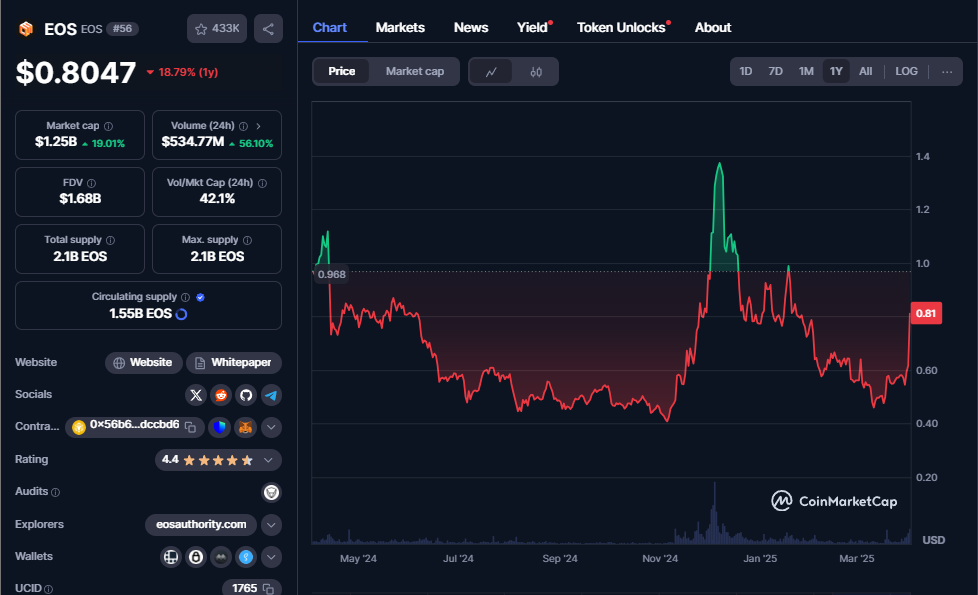
Is EOS a "resurrection" or a "last fight" before liquidity is exhausted? Let's look back on the ups and downs of the past seven years, dismantle Vaulta's movements, and explore the end of this 4.2 billion marathon - is it the rebirth of "Web3 Bank" or another tombstone in the cryptocurrency circle?
From ICO craze to technological failure, EOS’s “flash in the pan”
$4.2 billion "dream machine"
In 2017, the crypto world was in full swing with speculation. EOS caught the trend and called out the slogan of "the ultimate solution for blockchain": processing millions of transactions per second, no handling fees, and a developer paradise. This rhetoric attracted global funds like a magnet. In a full year of ICO, EOS attracted $4.2 billion, and ETH poured in like water, setting an unbeatable record. That year, the air in the currency circle was full of the smell of "all-in to get rich", and EOS became the most shining "dream machine".
In the spring of 2018, the price of EOS soared from $5 to $23, a monthly increase of more than three times, and its market value once ranked among the top five. The election of 21 super nodes became a global event, with exchanges, mining pools, and retail investors scrambling for positions, and the community was excited, as if EOS was the future "Blockchain United Nations". At that time, no one doubted that EOS would become the "Terminator of Ethereum", even Vitalik Buterin had to look at it with a frown.
DPoS’s “Game of Thrones” and Technical Shortcomings
EOS's killer feature is the DPoS (delegated proof of stake) mechanism, with 21 nodes responsible for block generation. In theory, its efficiency is higher than that of Bitcoin and Ethereum. But how is it actually operated? This system has become a "power concentration camp": large exchanges control nodes, and retail investors' voting rights are worthless; arbitration institutions on the chain are manipulated, and the farce of freezing accounts has caused trust to collapse. Some studies have also pointed out that most transactions on the EOS chain are "idle", and the activity is so low that it looks like a "digital desert".
Technically, "millions of TPS" has become the biggest joke. After the mainnet was launched, the actual peak was only more than 4,000, which was several orders of magnitude away from the publicity target. BM explained that "it has to rely on side chains", but a few years later, there are very few side chain ecosystems. At the same time, Ethereum broke through with layered technology, and new public chains such as Solana and BNB chain sprang up like mushrooms after rain, and EOS's "technical halo" completely faded. Someone joked: "EOS's TPS, I'm afraid it takes into account the 'millions of dreams per second'."
The “self-destruct mode” of user experience
EOS’ main selling point is “zero transaction fees”, but it requires users to exchange tokens for CPU and RAM resources. It sounds tempting, but it’s maddening to use: when the network is busy, resource prices soar, and the cost of transfers rises instead of falling; RAM is hyped to an outrageous level, and developers complain bitterly. During a peak period, thousands of EOS can only be exchanged for a few seconds of computing time, and the operation is as complicated as solving a math problem. Compared with Ethereum’s “simple and crude”, EOS’s DApp ecosystem is rapidly withering. By 2022, developers will run faster than rabbits, and even wallet and browser projects will be closed down.
Block.one’s “retreat” and the community’s “self-help path”
The mysterious flow of 4.2 billion yuan
When the EOS ecosystem collapsed, all eyes turned to Block.one: What about the $4.2 billion? The company's answer was to show off its "capital magic" with action. The funds on the account were invested in US Treasury bonds, Bitcoin, and even resort hotels, which had nothing to do with the EOS mainnet. Today, they own 160,000 BTC, and their net worth has skyrocketed to 16 billion, but they have turned a blind eye to the community's requests for help. The community was angry: "We are investing in public chains, not letting you use them to speculate in cryptocurrencies!" Someone joked: "Block.one is not a blockchain company, it is the Buffett of the crypto world."
Regulatory crackdown and internal chaos
In 2019, the SEC took action, accusing Block.one of illegal financing and fined it 24 million, which was just a drop in the bucket compared to 4.2 billion. The company paid the money and continued to "make a fortune in silence." The internal management was even more outrageous: BB operated as a family, with relatives in charge of marketing and investment, and there were a lot of money-burning projects, but few results. BM was marginalized and became a "name but no substance" technical facade. He spent more time on Twitter talking about the Bible and the end of the world than blockchain.
Community takeover and foundation rise: Why is EOS “dead but not stiff”?
Just when EOS seemed to be going out of business, the community stepped up. In 2021, the EOS Foundation (ENF), led by Yves La Rose, launched an "uprising" and united 17 nodes to kick Block.one out and take over control of the project. In the following years, the foundation fought a tug-of-war with Block.one. Although it did not get back the control of the 4.2 billion, it relied on its own efforts to pull EOS back from "half-dead" to "surviving".
Why didn't EOS die? To put it bluntly, Block.one did nothing, but the foundation was unwilling to accept it. They fought a lawsuit with the original project for several years and took over the lifeblood of EOS. In the past few years, the foundation has launched many new concepts: RAM resource optimization, exSat Bitcoin expansion, 1DEX decentralized exchange, and finally rebranded to Vaulta. EOS can survive until now, all thanks to the "die-hard" spirit of the ENF people.
Vaulta debuts and the new concept of "self-rescue experiment"
From public chain to "Web3 bank": Vaulta's transformation drama
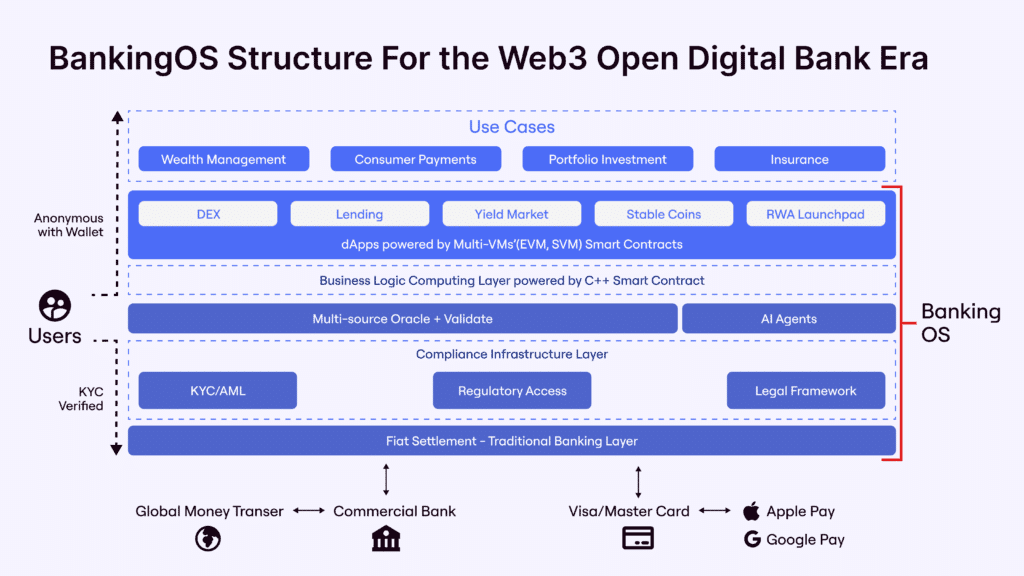
In March 2025, EOS announced that it would change its name to Vaulta, positioning itself as a "Web3 banking operating system" and using blockchain to reshape finance. The plan includes wealth management, consumer payments, investment portfolios, insurance, and a "bank advisory group" to support the scene. Tokens will be exchanged for new coins at a 1:1 ratio, and the exchange will start at the end of May, with an additional 17% annualized return on staking rewards - this combination of punches looks quite bluffing. Someone on X joked: "EOS has gone from being an 'Ethereum killer' to a 'Bitcoin little brother', and now wants to be a bank teller. It's really a versatile chain."
But a closer look shows that it is just a rehash of the past. Vaulta is based on the old EOS architecture, and its core selling point is the new project. Other features have already been used on Ethereum and Solana. The community has polarized reactions: optimists think it is a "bottoming out" while pessimists sneer at it: "It's just a name change to make money."
RAM, exSat, 1DEX, RWA: The Foundation’s New “Lifeline”
After the foundation took over, EOS's "self-rescue" relied on these four axes. Let's break them down one by one:
EOS RAM: Hidden Easter Eggs in the Memory Market: EOS's RAM (memory resources) is a unique design. On-chain storage relies on it. The supply is limited, but the usage increases with the growth of DApps. The foundation optimized the RAM mechanism and launched XRAM (extended RAM), allowing users to stake tokens in exchange for resources and share gas fees - and this gas fee goes directly to Bitcoin. This operation is very creative, binding EOS to BTC and taking advantage of the popularity of "digital gold". For example, users who stake a few hundred MB of XRAM can receive a share of gas fees in the form of BTC, which shows that there is still demand in the RAM market, especially new projects have pushed up its value. Some people joked: "RAM is more like an asset than EOS coins."
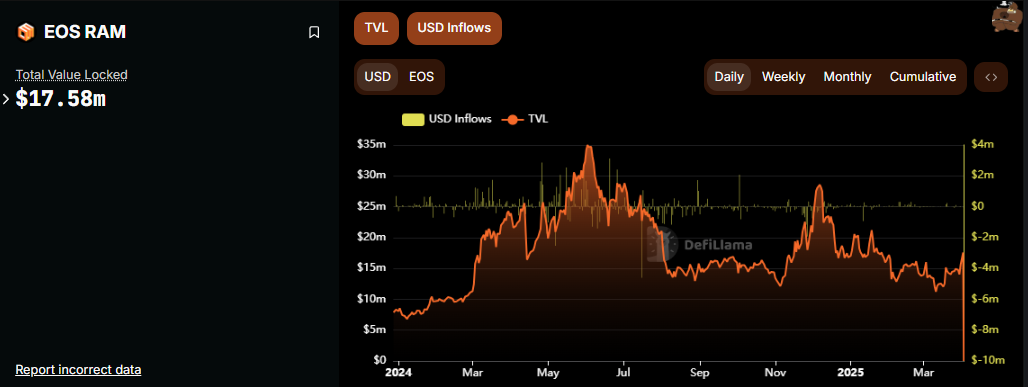
exSat: Bitcoin's EOS plug-in: exSat is a new attempt in 2024. It uses EOS's RAM to store BTC's UTXO data, hoping to solve the problems of slow and high-cost Bitcoin transactions. It sounds cool: BTC can run smart contracts and engage in DeFi, and EOS has transformed into "Bitcoin Layer 2". In March 2025, exSat locked 5,413 BTC with a total value of $587 million, far exceeding the EOS mainnet's $174 million, and has become the "new leader" of the ecosystem. But there are also many problems: the Bitcoin mechanism does not support staking, and the RAM capacity cannot support the big scene. The community questioned: "Isn't this just a big pie for BTC?"
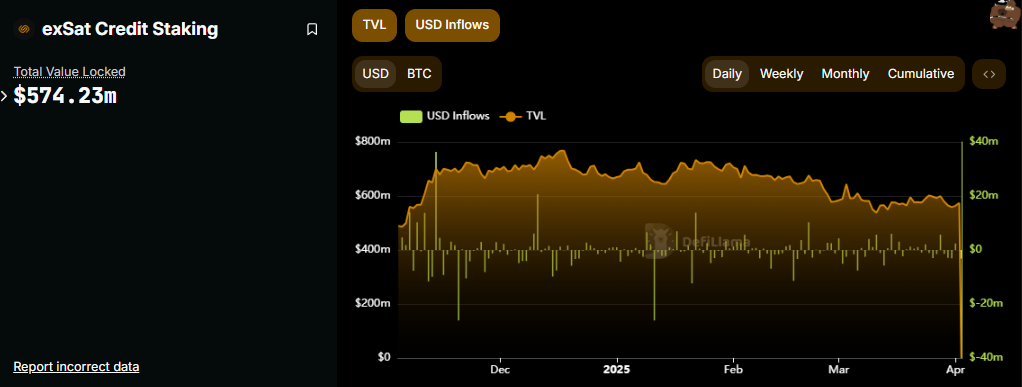
1DEX: A belated attempt at a decentralized exchange: 1DEX is a new DEX launched by EOS, aiming to make up for the shortcomings of DeFi. The EOS mainnet is fast (1 second block generation) and low-cost, which is theoretically suitable for trading. Unfortunately, the resource model was too complicated in the early years, and all the developers ran away. Now 1DEX is making a comeback. 1DEX supports unique asset trading and cross-chain operations, but EVM compatibility is not solved, the documentation is poor, and it looks like a "semi-finished product". A user on X complained: "If 1DEX was launched five years ago, EOS could still grab some market share, but it's a bit late now."
RWA: Vaulta holders will soon have access to exclusive investment options in tokenized real-world assets (RWA), including decentralized ownership in traditionally illiquid markets such as real estate, commodities, and equities. Strategic partnerships with leading tokenization platforms will unlock these sophisticated financial products, significantly enhance portfolio diversification, and promote vibrant, liquid markets.
Market boom: The “recovery moment” of a continuous 30% increase
On the day Vaulta was released (March 18), EOS soared 30%, from $0.65 to $0.84. Today (April 1), it has risen another 30%, breaking through $0.8021. The technical chart shows that it has broken through the key resistance level, and the trading volume has surged. Some people shouted "return to $1.4". What's more exaggerated is that someone on X raised a question: "Is EOS going to stage the drama of saving the currency circle in April 2018 again?" Many novices may be confused, but old leeks remember: In April 2018, EOS soared from $5 to $23, with a monthly increase of more than 360%. It led the entire bear market to rebound for a month and became the "market rescue hero" of that year.
Now Vaulta has risen by 60% in a row, and the technical aspects are perfectly matched, which inevitably makes people imagine - can this old horse really perform "dog head saving the world" again? However, old players sneered: "It's just a routine of pulling the market." OKX and Binance launched trading pairs ahead of schedule, and the quantitative robots "increased both volume and price", and the FOMO sentiment was ignited - this wave of continuous rise is like a "duet" of self-rescue by the foundation and hype of new concepts, or a preview of the miracle in 2018? It depends on the subsequent momentum.
The three major "behind-the-scenes drivers" of the surge
- Hot concept: Vaulta's "Web3 Bank" story is novel enough, and Bitcoin linkage and DeFi layout are both hot topics for speculation. As soon as the news came out on March 18, trading volume surged by 631%, and short-term buying pressure was very strong. On April 1, it took advantage of the momentum to rise by another 30%.
- Technical signal: The daily line broke through the box, and the short-term trend was bullish, attracting a large number of traders to enter the market. Some analysts even said that the descending triangle was broken, and the target was $1.4.
- The foundation is fighting a last-ditch battle: ENF has been holding its breath for the past few years, and the lawsuit has been fought successfully. exSat and 1DEX have gained some popularity, and the rebrand is a concentrated release, which has given EOS a new lease of life.
BTC share of XRAM pledged: the "weird highlight" of the ecosystem
In the EOS ecosystem, users who stake XRAM can receive a share of the gas fee in the form of BTC, which is quite intriguing. RAM is a scarce resource, and even if the main network is half dead, there is still a market, especially after the launch of exSat, the demand has surged. The gas fee is directly paid to BTC instead of EOS coins, indicating that the foundation no longer relies on the EOS token itself. After the replacement of Vaulta, the governance function may be further weakened. This "weird mechanism" has become a microcosm of EOS's transformation.
Can EOS still be caught up?
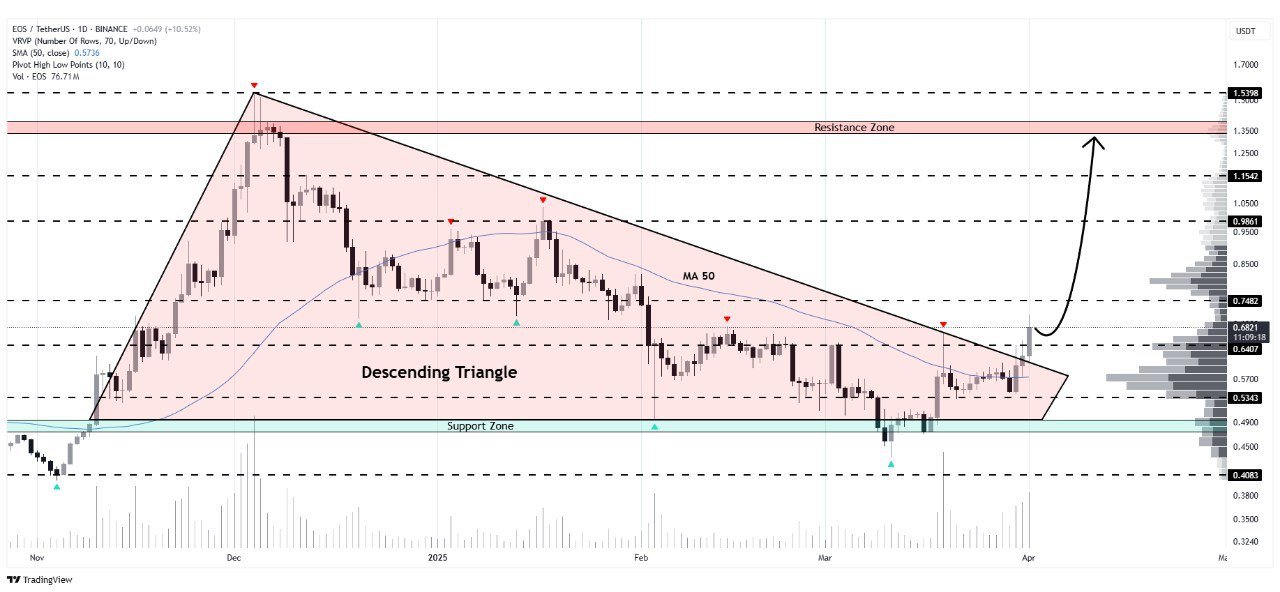
In the short term, if EOS can hold $0.8, $1.4 is possible, and it may even be hyped up to double digits. XRAM's BTC share can continue for a while, and it is a good strategy to flexibly adjust based on the progress of exSat. However, there are three major weaknesses in the long-term prospects:
- Competitive pressure: The Web3 banking track is not new. Ethereum has MakerDAO, Solana has Serum, and EOS does not have an advantage in technical foundation.
- Difficulties in implementation: exSat and 1DEX sound fancy, but their compliance and technical stability are questionable. It is still a big unknown whether Vaulta's blueprint can be implemented.
- Trust crisis: The "historical baggage" left by Block.one is too heavy, and no matter how hard the foundation tries, it will be difficult to completely clear itself of the shackles.
Conclusion
The seven years of EOS are a microcosm of the cryptocurrency circle's transition from enthusiasm to calm. $4.2 billion was used to create a "technological utopia", but it fell into decline due to poor user experience and chaotic management. After the foundation took over, RAM, exSat, 1DEX, and Vaulta became new ways to "save themselves", making EOS "dead but not stiff". This 30% rise is the blessing of new concepts and the carnival of market sentiment, but how far it can go depends on whether Vaulta can tell the story.
There is an old saying in the cryptocurrency circle: "The biggest risk of EOS is that you don't dare to take it." Facing this "old horse", do you dare to bet? Maybe you have to ask yourself if your heart is big enough. Because in the blockchain race, what is more unpredictable than code is the ups and downs of people's hearts. The XRAM share in your hand is still there, and the EOS marathon has not stopped - this 4.2 billion journey, whether the end is "bank" or "tombstone", time will give the answer.











